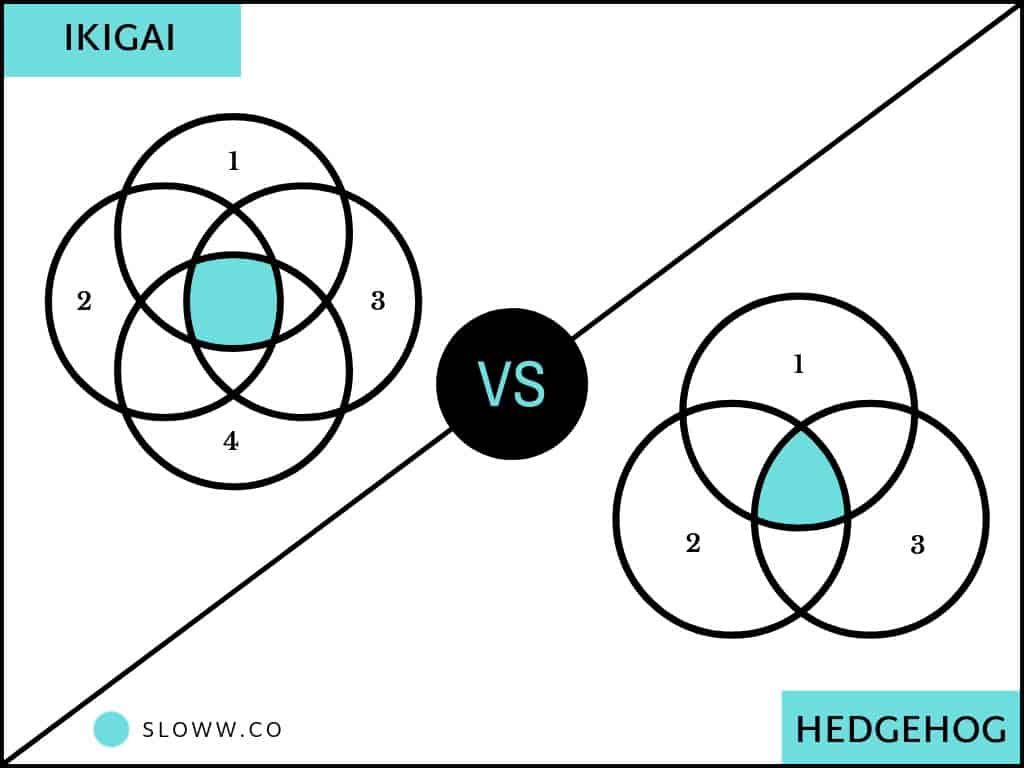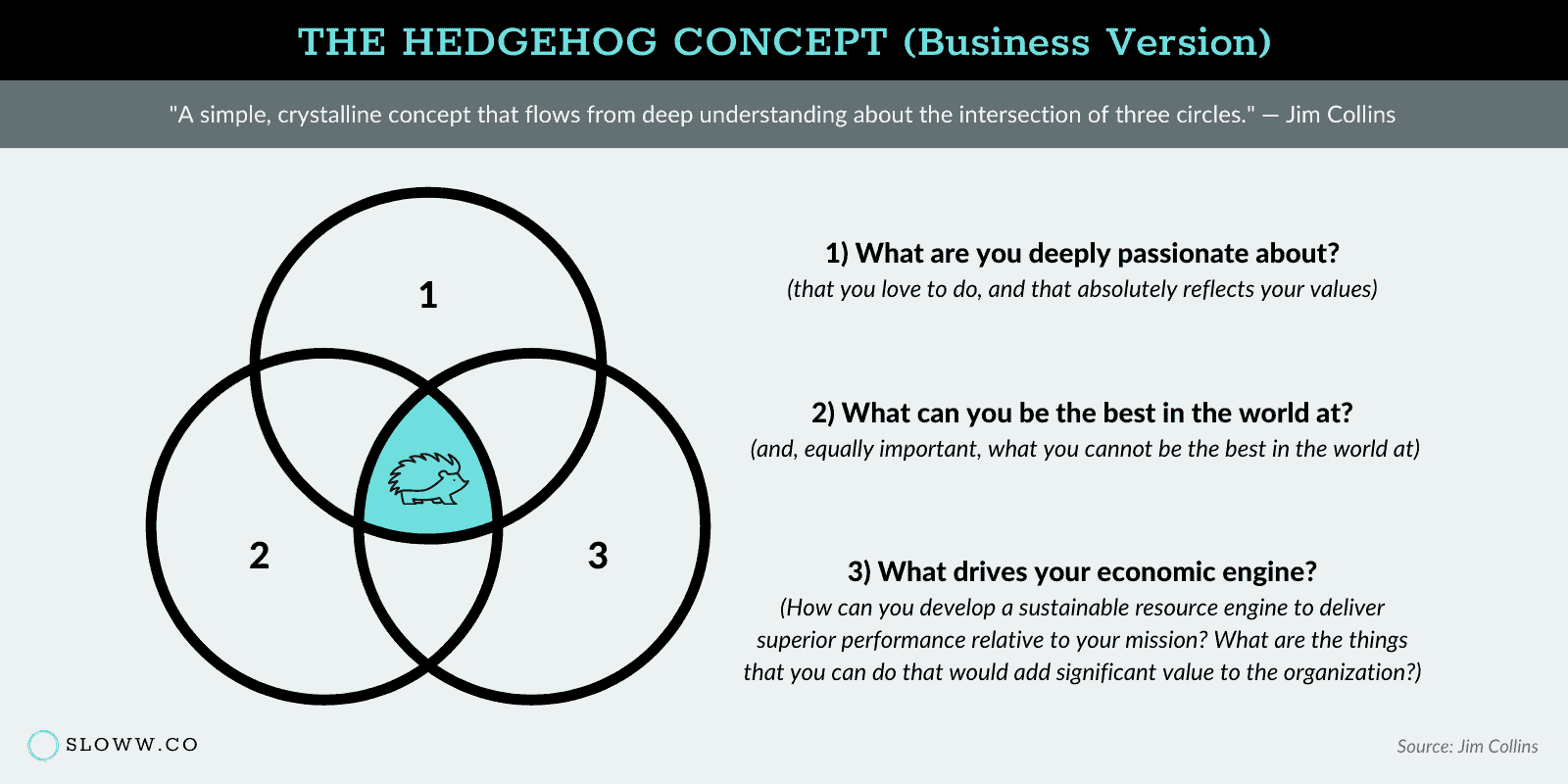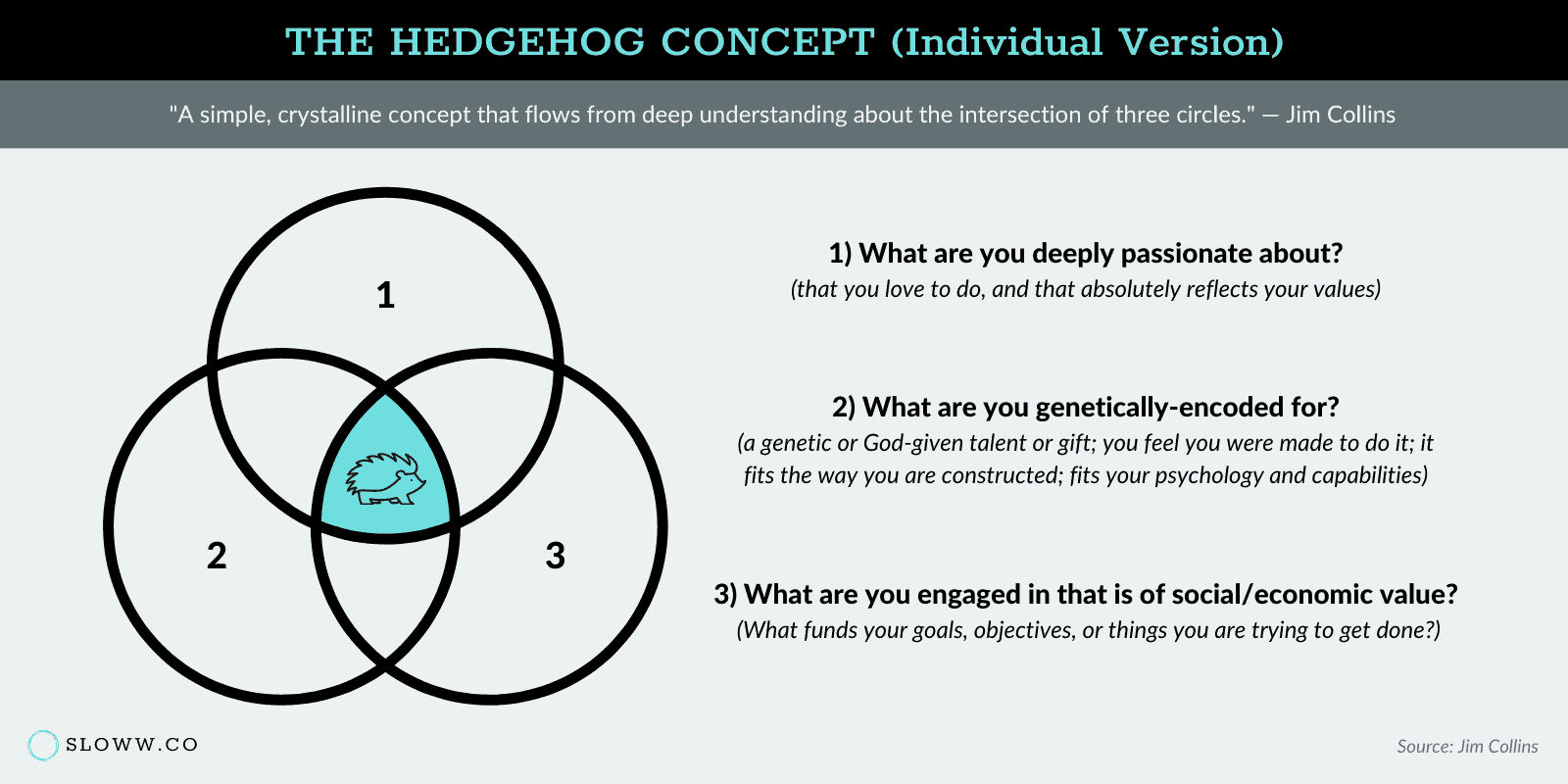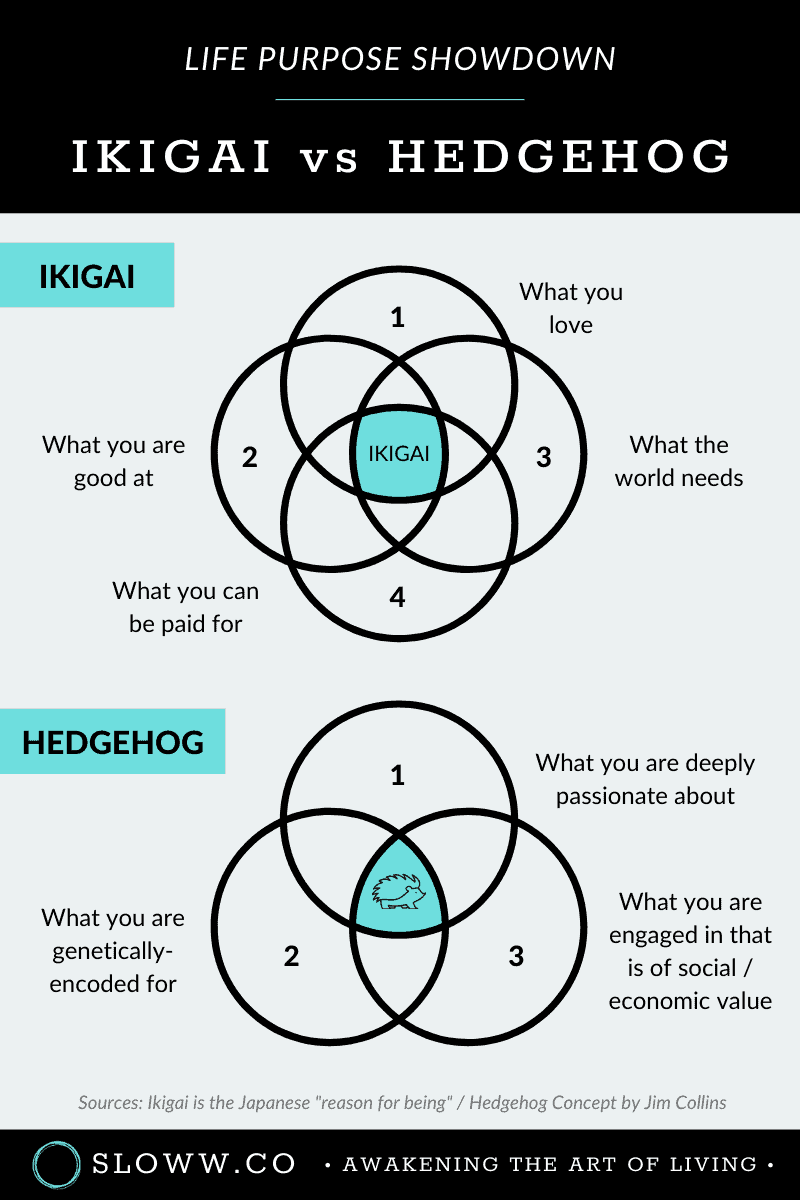In a previous post, we covered the flywheel effect by Jim Collins—along with an introduction and video on Collins.
This post covers another one of his famous ideas: the Hedgehog Concept. As you’ll quickly see, the Hedgehog Concept bears a striking resemblance to the Japanese concept of ikigai. Are these two concepts really as similar as they appear?
“All good-to-great leaders, it turns out, are hedgehogs. They know how to simplify a complex world into a single, organizing idea—the kind of basic principle that unifies, organizes, and guides all decisions.” — Jim Collins

What is the Hedgehog Concept by Jim Collins? (& How Does it Compare to Ikigai?)
Let’s start with the Hedgehog Concept
The Hedgehog Concept was originally developed by Jim Collins in his book “Good to Great” (Amazon) in relation to business.
In Jim’s own words, the Hedgehog Concept is “a simple, crystalline concept that flows from deep understanding about the intersection of three circles”:
- What are you deeply passionate about? (that you love to do, and that absolutely reflects your values)
- What can you be the best in the world at? (and, equally important, what you cannot be the best in the world at)
- What drives your economic engine? (How can you develop a sustainable resource engine to deliver superior performance relative to your mission? What are the things that you can do that would add significant value to the organization?)
Here are a few notes from Jim on being “best in the world”:
- “A Hedgehog Concept … is an understanding of what you can be the best at.”
- “Few actually understand—with piercing insight and egoless clarity—what they actually have the potential to be the best at and, just as important, what they cannot be the best at.”
- “Doing what you are good at will only make you good; focusing solely on what you can potentially do better than any other organization is the only path to greatness.”
Here’s what the business hedgehog looks like:

The second circle changes from “best in the world” to:
- What are you genetically-encoded for? (a genetic or God-given talent or gift; you feel you were made to do it; it fits the way you are constructed; fits your psychology and capabilities)
The third circle may become something like this:
- What are you engaged in that is of social and/or economic value? (What funds your goals, objectives, or things you are trying to get done?)
Here’s what the individual hedgehog concept looks like:

This is a great video of Jim Collins sharing the concept for people. He guesses maybe only 3-5% of everyone on Earth has figured out their hedgehog. Could you imagine a world where 20% find it?
What is it like living within the alignment of all three circles? Collins says:
- “If you could drive toward the intersection of these three circles and translate that intersection into a simple, crystalline concept that guides your life choices, then you’ve got a Hedgehog Concept for yourself.”
- “When all the pieces come together, not only does your work move toward greatness, but so does your life. For, in the end, it is impossible to have a great life unless it is a meaningful life. And it is very difficult to have a meaningful life without meaningful work. Perhaps, then, you might gain that rare tranquility that comes from knowing that you’ve had a hand in creating something of intrinsic excellence that makes a contribution. Indeed, you might even gain that deepest of all satisfactions: knowing that your short time here on this earth has been well spent, and that it mattered.”
- “When you get your Hedgehog Concept right, it has the quiet ping of truth … There is no need to say much of anything; the quiet truth speaks for itself.”
How does the Hedgehog Concept compare to Ikigai?
The viral version of ikigai (which doesn’t necessarily represent the truth about ikigai) is the intersection of four circles:
- That which you love
- That which you are good at
- That which the world needs
- That which you can be paid for
Here’s how ikigai looks compared to the Hedgehog Concept:

At first glance, there are some things that are exactly the same:
- Circle 1: What you love/are deeply passionate about
- Circle 4 (Ikigai) & Circle 3 (Hedgehog): What you can be paid for / is of social and/or economic value
How about the differences?
- Circle 4 (Ikigai): The most obvious difference is that the Hedgehog Concept only has three circles while ikigai has four circles. However, after hearing Jim Collins explain his concept, I believe he has this circle (“what the world needs”) baked into his concept as a mandatory and therefore doesn’t explicitly say it. But, just because it’s a no-brainer for him doesn’t mean it is common sense to the rest of us, so I like the fact that the ikigai model specifically states it.
- Circle 2: Jim Collins makes it very clear in the Hedgehog Concept (for people) that what you are good at is not the same as what you are encoded to do. I very much agree with him based on my own personal experiences in life. I believe “what you are encoded for” is another form of “know thyself.” It really requires you to take a deep, honest look inside yourself.
Your Hedgehog (or Ikigai) + Flywheel Momentum
Let’s say you’ve done the hard work of finding your ikigai or hedgehog. Then what?
Then you start building momentum by using what Jim Collins calls the Flywheel Effect:
- “I’m not a big believer in thinking of traditional careers, I’m a big believer in thinking of finding your Hedgehog, and then really building flywheel momentum with that over time.”
- “Transformations from good to great come about by a series of good decisions made consistently with a Hedgehog Concept, supremely well executed, accumulating one upon another, over a long period of time.”
- “On average, it took four years for the good-to-great companies to crystallize their Hedgehog Concepts. It was an inherently iterative process—consisting of piercing questions, vigorous debate, resolute action, and autopsies without blame—a cycle repeated over and over by the right people, infused with the brutal facts, and guided by the three circles.”
I’ll leave you to ponder the challenge that Jim Collins issues at the end of the video above:
- “He (Maslow) defined self-actualization as discovering what you are meant to do and committing to the ardor of pursuing it with excellence. The purpose of free society, I would suggest, is to systematically increase the percentage of people who do exactly that.“
Have you found your hedgehog or ikigai?
If so, please let me know what it is in the comments!
You May Also Enjoy:
- Get the new eBook: Ikigai 2.0: A Step-by-Step Guidebook to Finding Life Purpose & Making Money Meaningfully (+ Bonus Workbook)
- Build Momentum for your Life Purpose with the Flywheel Effect by Jim Collins
- The Truth about Ikigai: Definitions, Diagrams & Myths about the Japanese Life Purpose
- Ikigai 2.0: Evolving the Ikigai Diagram for Life Purpose (& Why and How it Needs to be Redesigned)
- My Ikigai 2.0 — A Detailed Personal Ikigai Example of How to Find Your Life Purpose
Sources:
- https://www.jimcollins.com/concepts/the-hedgehog-concept.html
- https://www.jimcollins.com/article_topics/articles/hedgehog-concept-business-sectors.html#articletop
- https://tim.blog/2019/02/18/jim-collins/ & https://tim.blog/2019/02/20/the-tim-ferriss-show-transcripts-jim-collins-361/





